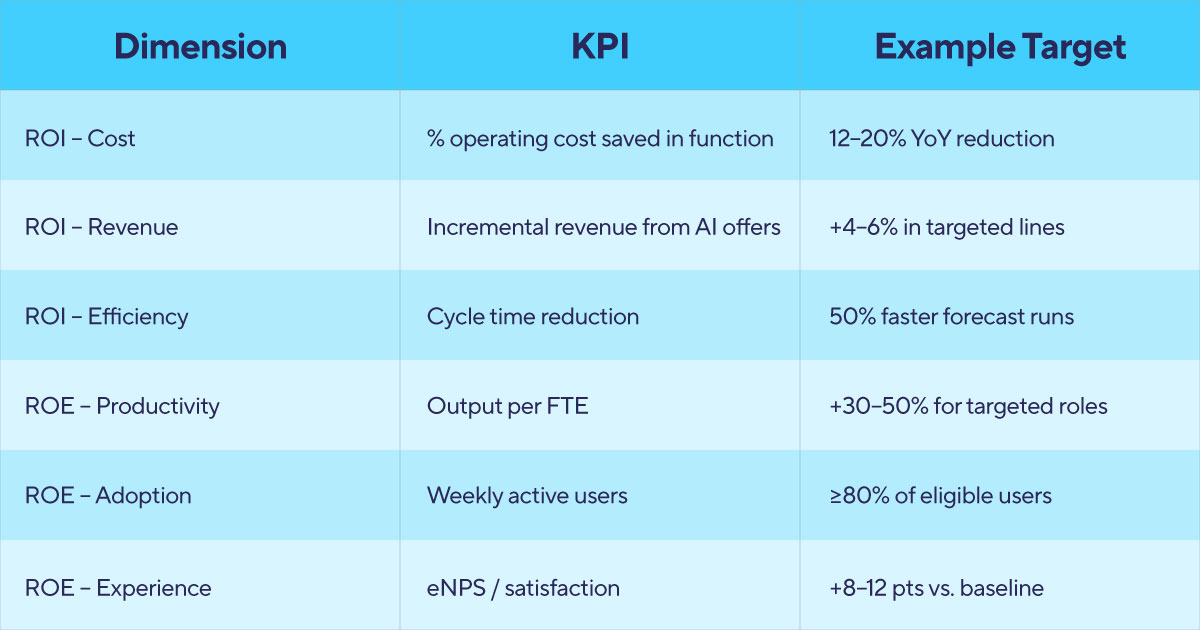What if your finance team could forecast revenue swings in minutes instead of days? What if customer-facing teams had AI-driven insights to personalize every interaction at scale, and your operations group could eliminate manual bottlenecks overnight? In 2025, these scenarios are no longer science fiction – they’re becoming business expectations. Yet, many enterprises still fall short of realizing full AI maturity, hindered by fragmented data, talent gaps, unclear governance, and lack of alignment with business objectives. The urgency is clear: companies plan to boost AI spending (92% expect to increase investments over the next three years), but only 1% of leaders currently define their organizations as “AI mature.”
How can enterprises bridge this gap? By steering AI with twin north stars: ROI (Return on Investment) and ROE (Return on Employee). These metrics ensure AI initiatives drive financial returns and empower employees. 2025 is the year to move from AI vision to execution, with ROI and ROE as guiding lights.
Defining ROI & ROE for AI
ROI measures the traditional financial return of AI initiatives. It balances the costs of AI – from platforms and data infrastructure to talent and training – against the tangible benefits like cost savings and revenue uplift.
ROE (Return on Employee), by contrast, focuses on people impact – how AI increases the productivity, capability, and engagement of your workforce. While ROI asks “What did we get for the money we spent?”, ROE asks “What did we get for our people in terms of enablement and growth?” In essence, ROE metrics gauge how much more effective, empowered, and satisfied your people are as a result of AI. A truly successful AI program maximizes both ROI and ROE – reducing costs and elevating employees – to drive sustainable performance.

Translating vision into objectives
A grand AI vision must translate into concrete objectives and use cases. The key is to balance quick wins vs. strategic bets. Move beyond ad-hoc AI projects to a holistic AI strategy aligned with your core business objectives. Prioritize use cases that deliver clear, measurable ROI and address critical business problems. In most cases, it’s highly beneficial to hire external experts to help evaluate your opportunities, as they lack company-specific cultural bias and can offer innovative solutions based on extended expertise in the field.
Are you ready for AI?
Before diving into implementation, companies should conduct an AI Readiness Assessment across three critical dimensions:
People
- Do we have the right talent and culture?
- Are roles like product owners, data/ML engineers, and change leaders clearly defined?
- What’s the baseline AI literacy, and where do we need upskilling or hiring?
- Is employee sentiment favorable or resistant toward AI adoption?
Evaluate your workforce’s skills and openness. Identify expertise gaps and plan accordingly. Many leaders cite “talent skill gaps” as the top barrier to AI adoption; address this proactively with training programs or expert partnerships with established companies.
Processes
- Are business workflows standardized?
- Are decision rights and controls clearly defined for AI model outputs?
- How integrated, clean, and governed is your data?
AI thrives on robust data infrastructure and standardized workflows. Fragmented or siloed data and processes can stall AI initiatives. A readiness check may reveal immediate steps required to fix data pipelines or unify disparate systems before launching ambitious AI projects.
Technology
- Can current IT architecture handle AI requirements?
- Are data sources easily integrable?
- Do systems support real-time processing and scalability?
- Are security and compliance frameworks robust enough for AI deployments?

Assess technology infrastructure critically. Legacy systems or weak security frameworks can impede rapid AI deployment. Consider targeted upgrades or scalable cloud solutions to support initial pilots and future growth.
Addressing all these questions is paramount before you start building your AI initiatives. If you find that you have gaps in your talent pool, knowledge base, or technology stack, don’t worry – it’s quite normal for most businesses. That’s where Sirma’s team of AI experts can help. With over three decades of experience in AI, we can help you bridge those gaps seamlessly and efficiently, ensuring optimal resource allocation and clearer pathways to AI maturity.
Building the roadmap: pilot to scale
With prioritized use cases in hand and organizational readiness evaluated, it’s time to plot the AI roadmap – moving from initial idea to full-scale deployment. The current situation in AI development is volatile, and groundbreaking advancements are reported daily. A staged approach is crucial to manage risk and change.
Proof of Concept (POC) - Develop a simple model or use a vendor demo; have a few end-users try it; measure initial results against a baseline.
Pilot - Implement the AI solution in one business unit or location (e.g. one warehouse, or a subset of customer service reps). Monitor performance closely (collect ROI/ROE metrics), gather user feedback, and iterate. Also start drafting governance policies and integration plans.
MVP (Minimum Viable Product) - Develop a robust version of the solution with core features, ready for broader adoption. Incorporate learnings from the pilot to build a scalable solution. Ensure it integrates with enterprise systems (ERP, CRM, etc.), and address security, data privacy, and compliance requirements. Establish supporting processes (e.g. model monitoring, incident response). Begin formalizing change management: user training, support, and documentation.
Enterprise Rollout - Scale the AI solution across the organization for full business impact. Roll out to all relevant departments/locations in phases. Implement an AI governance framework to oversee value tracking, risk management, and continuous improvement. Institute data stewardship for ongoing data quality and model retraining. Invest in upskilling programs so employees can effectively work with the new AI (or take on new roles created by AI).
During each phase, governance and change management are as important as the tech work. From the pilot stage onward, define clear governance roles: Who approves moving from pilot to scale? Who is accountable for model ethics and performance?
Many organizations partner with Sirma to establish an AI governance board early to review use cases for bias, compliance, and alignment to strategy. Should resource constraints arise during any phase—from Pilot through Enterprise Rollout—our experienced specialists are ready to take over end‑to‐end responsibilities, ensuring a smooth deployment.
Future-proof your initiatives
Future-proofing AI deployment means designing for constant change: new models appear almost daily, tooling evolves rapidly, and regulatory frameworks shift frequently. Recent advancements, such as the rapid emergence of agentic AI models (e.g., DeepSeek) demonstrate the necessity of agility. The only sustainable approach is to be model-agnostic, modular, and observable by default, allowing quick integration or replacement without extensive business disruption.
Sirma’s Enterprise AI Core Platform was built for this reality: an agentic architecture with standard inter-module protocols, a retrieval-augmented (RAG) layer for portable knowledge, and plug-in adapters that let you upgrade or replace LLMs on demand while preserving prompts, guardrails, and integrations.
Real-world AI success stories
Retail Ada Mall, leveraging Sirma’s Salexor AI platform, transformed anonymous web traffic into qualified leads, achieving a 30% conversion rate. Real-time analytics personalized customer interactions, significantly enhancing tenants’ marketing ROI and driving an 8% projected property value increase—delivering clear financial returns while streamlining and automating customer support and engagement processes.
Financial Services Postbank’s implementation of EVA, a credit chatbot developed by Sirma, automated routine customer interactions, allowing 24/7 personalized assistance. Integrated directly into Facebook Messenger, EVA improved customer convenience and allowed staff to focus on complex tasks, demonstrating tangible efficiency gains and improved employee focus and productivity.
Retail/E-commerce SPORT DEPOT deployed Sirma’s Agentic AI Assistant, automating 80% of customer inquiries immediately upon implementation. This significantly reduced call-center load, optimized operational efficiency, and improved customer satisfaction through instant support. Employees experienced reduced workload and more time to handle complex scenarios, delivering simultaneous operational cost reductions and employee empowerment.
Insurance Pets Best partnered with Sirma to automate its high-volume claims process using AI-driven OCR and machine learning. This intelligent system boosted productivity by 300%, minimizing human intervention and accelerating claim decisions. The streamlined approach resulted in rapid, consistent claim processing, improving both operational efficiency and employee satisfaction by reducing manual, error-prone tasks.
Conclusion
AI’s promise is now pragmatic: forecast in minutes, serve customers in seconds, operate with fewer errors at lower cost. The leaders are those who architect for ROI and ROE together, turning AI into a compounding advantage across growth, efficiency, and experience.
Sirma’s Enterprise AI Core Platform embodies that approach: an end-to-end, agentic, RAG-enabled fabric that integrates functions, enforces governance, and accelerates scale, built by a team that has powered critical systems for decades. If you’re ready to align AI with your business goals and give your people better tools to do their best work, now is the moment to move.


